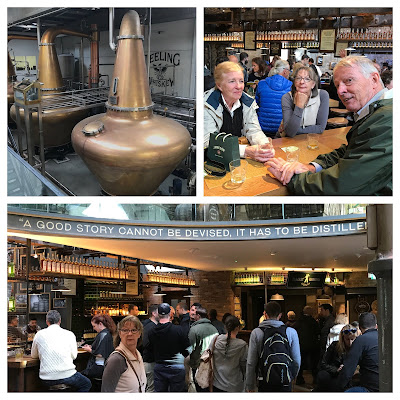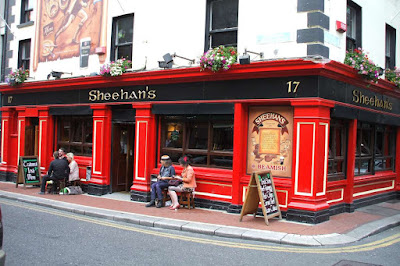As we step out into the early morning darkness, she's afraid that I'm going to get lost or do something stupid so the dog makes me hold on to one end of the leash so she can lead me home if I go terribly astray. The streets are quiet save for the roosters calling out their morning prayers, and the only other sign of life is the flash mob of street dogs appearing, disappearing in the spotlight of the street lamps as they rush frantically, noses to the ground, back and forth across the cobblestones.
I lift my head into the cool morning breeze and head off intently toward no place in particular but the dog's interests lie in the opposite direction, closer to the cobblestones. She is as intent in pursuing her pleasures as I am in mine and so the morning tango begins. Two quicksteps "adelante" as she drags me toward the curb, an abrupt twisting "media vuelta" and a stumbling "atrás" as I attempt to regain my balance and rein her back in, followed by an elaborately executed "corrida garabito" in which we both end up hopelessly entangled in the leash. We continue our hesitant tango for the entertainment of the adobe walls, the amusement of the cobblestones, the silent applause of the moonlight as we dance a little "contrapaso" onto the next block and then round the corner into the final stretch home.
The narrow view down this Mexican street as night meets day and the pink rip in the sky tilts toward orange, makes me question once again, "Did I forget to unplug the toaster?" I've seen this before. Was it the footage of the wildfires raging across California, or that spectacular pipeline explosion in Texas?
It makes me wonder if Dante Alighieri once lived here. Was this the ethereal light that he struggled to describe in the final canto of the Paradiso? Did Homer walk his dog here too in the early morning hours but neglect to mention Ajijic as the forgotten town in the Odyssey as the source of the repeated epithets extolling the "rhododactylos Eos", the "rose fingered dawn"?
It makes me wonder if Dante Alighieri once lived here. Was this the ethereal light that he struggled to describe in the final canto of the Paradiso? Did Homer walk his dog here too in the early morning hours but neglect to mention Ajijic as the forgotten town in the Odyssey as the source of the repeated epithets extolling the "rhododactylos Eos", the "rose fingered dawn"?
Some mornings Eos arrives as an explosive spectacle, a fiery chariot drawn by powerful horses blazing into the sky accompanied by the endless scheming and chattering of Homer's gods, this morning she appears as a waif, pale and thin, arriving silently, hesitantly, a lonely refugee from the night. Still, not a bad way to begin the day, or to bring yet another year to a close.
We follow the malecon home but our morning tango is brought to an abrupt halt as we stroll onto the bridge and nearly fall into the arroyo. The entire structure is deteriorating. The surface looks more like a cheese grater than a bridge, with several holes large enough to swallow a small dog.
We approach the largest hole and stare into the void half expecting to find Wile E. Coyote clinging to the edge of the abyss, or perhaps, I thought, this is simply the opposite end of Dante’s extraordinary poem, the place that inspired the opening cantos of The Divine Comedy. I kneel down placing my ear close to the hole, listening for the eldritch voice of Virgil murmuring an invitation to descend into the nine circles below. I think about trying to block off the hole or at least put up a warning sign, but all I can find is a large paper cup. I think about scrawling a message on it and placing it over the hole,"Lasciate ogne speranza, voi ch'intrate", “Abandon hope, all ye who enter here”, but I figure the message along with the cup would be lost.
Safe at home, as the dog nudges aside the cat and heads for her water bowl, I sit with my coffee, and relate our morning adventure to my wife and I’m delighted to hear that the Garden Guild is (not surprisingly) way ahead of me on the need for bridge repair. The Garden Guild has for years contributed to the community in ways large and small and this year they have raised the money and reached out to forge partnerships with Hector España Ramos, Inside Lakeside, the Municipality, Have Hammers, and others to make the necessary repairs to both bridges and ensure that the malecon remains the heart and soul of Ajijic. Building bridges with the community is something the Garden Guild has excelled at for many years, and this latest project is no exception.
So the dog and I look forward with great anticipation to the completion of the project in the next few weeks when we can dance down the malecon once again, crossing the bridges without being provoked to contemplate the void, and instead turn all our attention to yet another spectacular sunrise. But the leash is still a hindrance to our morning tango so I practice hard to gain the confidence of my dog in the hope that one day perhaps she will let me leave home without it.










































